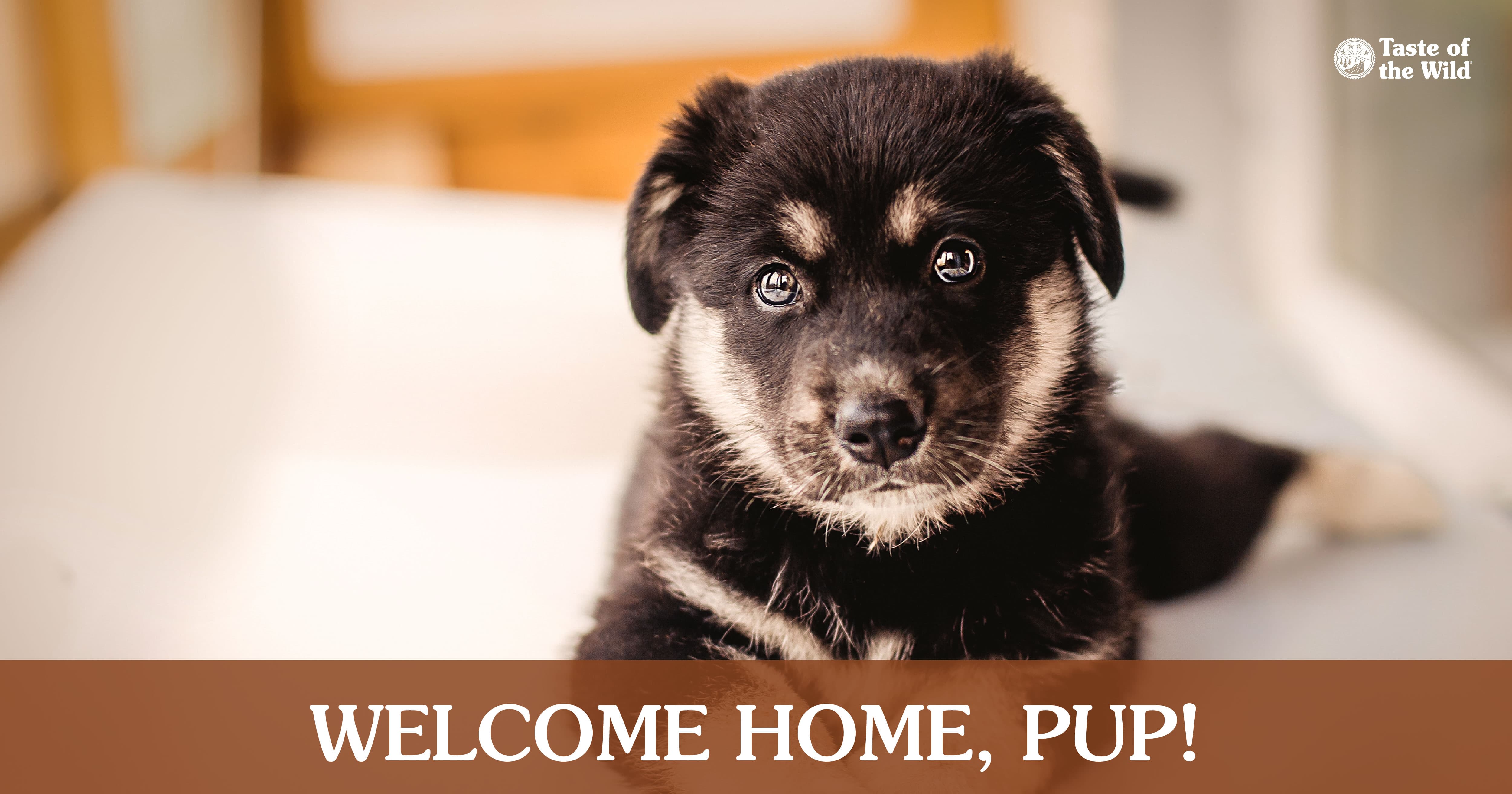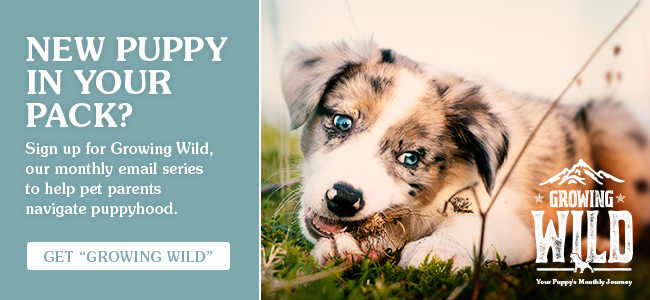
It’s puppy time! Your new puppy is here and ready to explore their furever home. But are you ready for puppy’s first week at home? You’ve got food bowls, chew toys and a cozy bed, but what should you do now that they’re here? We have some tips to make your puppy’s transition to their new home as safe and as stress-free as possible.
Safe and Supervised Sniffing
One of the first things your new puppy is probably going to do is smell everything. Puppies are born deaf and their eyes are closed for the first 2 to 3 weeks, but that nose works hard from day 1 and doesn’t stop. Your curious puppy will want to explore every nook and cranny in your house and that may include places they shouldn’t be and objects they shouldn’t be touching.
It’s best to puppy-proof your house before you welcome your new puppy home. That way you know the house is (relatively) safe. There are always going to be things that you didn’t think they could get into but they somehow find a way. So for the first few days, supervise their exploration time so you can watch out for hazards that you may have missed.
Some items that should be kept out of a puppy’s reach include electrical cords, sharp objects and anything else puppies shouldn’t be chewing on (e.g., stinky trash, your fluffy pillow, the TV remote). Make sure you put away anything toxic to dogs like medicines, cleaning chemicals, poisonous plants, human-only food (e.g., grapes, onions, chocolate) and anything else that might harm a nosy puppy.
Help Make Nighttime Less Scary
Have you ever stayed in a new place (e.g., hotel, cabin, friend’s house) and woken up in the middle of the night and forgotten where you were? Scary, right? Think about how scary a new home would be for a little pup (especially at night) with all of those strange new sounds, smells and surroundings.
Plus, depending on where you adopted your new puppy, they were probably with their mom, siblings or had other dogs around them that they knew, and now they’re alone or with unfamiliar dogs. According to VetBabble, when puppies are separated from the pack for the first time, their natural instinct is to be as loud as possible. So it’s likely that your new pup is going to cry (howl, whine or whimper) for a few days or even a few weeks when they’re alone.
You can make nighttime a little more comforting for your puppy by choosing a quiet area of your house for their bed. Make them a snuggly bed in a crate so they will have a secure space to make their own — and keep them out of mischief while you’re asleep. Putting a piece of your clothing near their crate can be comforting for them, plus it will help with bonding. Just make sure it’s far enough away that they don’t use it as a chew toy. You could also consider placing the crate in your bedroom, but if you would like your puppy to sleep in your bed, hold off until they’re potty trained — because, well, you get it.
Spend Time with Your New BFF
Nighttime isn’t the only part of the day that can be scary for a puppy — being left alone during the day can be worrying and overwhelming for your puppy, too. If possible, schedule some vacation days for the first few days that your pup is adjusting to their new home. It will help with bonding, and your puppy will have a friend with them while they’re exploring their new digs. If you can’t be home with them all day, see if a family member or a friend can stay with your puppy, or consider hiring a pet sitter while your puppy is settling in.
Practice Alone Time
Being left alone is going to happen eventually, though. Even if you work from home, there will still be times when you need to go out and you can’t take your little buddy with you. It’s important that your new sidekick learns how to handle being alone and that it isn’t something to worry about.
Certified Professional Dog Trainer (CPDT-ka) and Certified Separation Anxiety Trainer (CSAT) Shoshi Parks, PhD, has some useful tips on how to help your puppy become comfortable with being alone. First of all, place your puppy in their crate (or other confined space) with a high-value treat or toy and leave the house for five minutes. You’ll probably hear some barking or whining which is normal. Quickly come back in when there’s silence. It’s important to wait for a break in their barking otherwise they’ll learn that making noise is what makes you come back. Once they’re used to you being away for five minutes, try extending the time little by little.
Eventually your pup should learn that being alone isn’t too bad and that you do come back. Separation anxiety can occur in dogs of all ages, so it’s a good idea to start teaching them that alone time isn’t bad during your puppy’s first week at home.
Time to Go Potty. Again.
Stock up on cleaning supplies because you’re gonna need ’em. A lot. Potty training is another thing that should be started the day you bring your puppy home. But it’s going to take some time and quite a few potty accidents before they get the hang of it — which probably won’t be until they’re around 12 to 16 weeks old.
You can help reduce the number of accidents by taking your puppy on potty breaks every two to four hours — including in the middle of night, if needed. Crate training can also help with potty training because dogs are naturally averse to soiling their “den,” so they will go potty somewhere else. By taking them out of their crate and then immediately outside or to the designated potty place inside, they will learn that that’s where they need to go when they need to go. Eventually they will realize that your whole house is their “den” and not a place to go potty.
Stick to a Schedule
Consistent messaging and keeping to a routine are really important for helping your puppy adjust to their new home and family. Stick to the same schedule (as much as possible) for mealtimes, bedtime, play sessions and potty breaks. And if you have rules that your puppy needs to follow, make sure all of your household is enforcing the rules. If pupster isn’t allowed on the couch, you shouldn’t pull them up for a quick snuggle. It will just confuse them when they get in trouble for jumping onto the couch the next day.
Feeding Your Puppy
For mealtimes, veterinary nutritionists recommend feeding puppies at least two meals and possibly three or four meals daily until your puppy is 4 to 6 months old. Once they’re 6 months old you can stick with two meals a day, although some large and giant breeds may benefit from three meals a day. Feeding the right food is important to ensure your puppy grows into a healthy dog at the correct rate. Your veterinarian can help you determine the best food for your puppy and how much they should be eating.
The first week with a new puppy can be overwhelming and a little scary for both of you. But spending quality time with your puppy and setting up a routine will help everyone adjust in no time. Don’t forget to schedule your pup’s first visit with their veterinarian, too!
POST: Socialize Your Puppy Now for a Friendlier Tomorrow
The information in this blog has been developed with our veterinarian and is designed to help educate pet parents. If you have questions or concerns about your pet's health or nutrition, please talk with your veterinarian.

